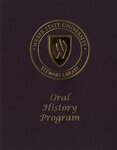| Title |
Johnson, Cliff OH12_033 |
| Creator |
Weber State University, Stewart Library: Oral History Program |
| Contributors |
Johnson, Cliff, Interviewee; Rands, Lorrie, Interviewer; Whitesides, Rebekah, Technician |
| Collection Name |
Business at the Crossroads-Ogden City Oral Histories |
| Description |
Business at the Crossroads - Ogden City is a project to collect oral histories related to changes in the Ogden business district since World War II. From the 1870s to World War II, Ogden was a major railroad town, with nine rail systems. With both east-west and north-south rail lines, business and commercial houses flourished as Ogden became a shipping and commerce hub. |
| Abstract |
The following includes the transcript and a video clip from an oral history interview with Cliff Johnson. |
| Image Captions |
Cliff Johnson |
| Subject |
Twenty-fifth Street (Ogden, Utah); Business; Small business |
| Digital Publisher |
Stewart Library, Weber State University, Ogden, Utah, USA |
| Date |
2013 |
| Date Digital |
2017 |
| Temporal Coverage |
1924; 1925; 1926; 1927; 1928; 1929; 1930; 1931; 1932; 1933; 1934; 1935; 1936; 1937; 1938; 1939; 1940; 1941; 1942; 1943; 1944; 1945; 1946; 1947; 1948; 1949; 1950; 1951; 1952; 1953; 1954; 1955; 1956; 1957; 1958; 1959; 1960; 1961; 1962; 1963; 1964; 1965; 1966; 1967; 1968; 1969; 1970; 1971; 1972; 1973; 1974; 1975; 1976; 1977; 1978; 1979; 1980; 1981; 1982; 1983; 1984; 1985; 1986; 1987; 1988; 1989; 1990; 1991; 1992; 1993; 1994; 1995; 1996; 1997; 1998; 1999; 2000; 2001; 2002; 2003; 2004; 2005; 2006; 2007; 2008; 2009; 2010; 2011; 2012; 2013 |
| Item Size |
22p.; 29cm.; 2 bound transcripts; 4 file folders. 1 video disc: digital; 4 3/4 in. |
| Medium |
oral histories (literary genre) |
| Spatial Coverage |
Ogden (Utah); 25th Street (Utah) |
| Type |
Image/MovingImage; Text |
| Conversion Specifications |
Filmed using a Sony HDR-CX430V digital video camera. Sound was recorded with a Sony ECM-AW3(T) bluetooth microphone. Transcribed using WAVpedal 5 Copyrighted by The Programmers' Consortium Inc. Digitally reformatted using Adobe Acrobat Xl Pro. |
| Language |
eng |
| Rights |
Materials may be used for non-profit and educational purposes, please credit University Archives, Stewart Library; Weber State University. |
| Source |
Johnson, Cliff OH12_033; Weber State University, Stewart Library, University Archives |
| Format |
application/pdf; video/mp4 |
| ARK |
ark:/87278/s65tjpd4 |
| Setname |
wsu_webda_oh |
| ID |
104205 |
| Reference URL |
https://digital.weber.edu/ark:/87278/s65tjpd4 |
| Title |
Johnson, Cliff OH12_033 |
| Creator |
Weber State University, Stewart Library: Oral History Program |
| Contributors |
Johnson, Cliff, Interviewee; Rands, Lorrie, Interviewer; Whitesides, Rebekah, Technician |
| Description |
Business at the Crossroads - Ogden City is a project to collect oral histories related to changes in the Ogden business district since World War II. From the 1870s to World War II, Ogden was a major railroad town, with nine rail systems. With both east-west and north-south rail lines, business and commercial houses flourished as Ogden became a shipping and commerce hub. |
| Image Captions |
Cliff Johnson |
| Biographical/Historical Note |
The following is an oral history interview with Cliff Johnson, conducted in his home by Lorrie Rands on September 19, 2013. Cliff discusses his memories of 25th Street, including his paper routes, the Bamberger street car, and multiple robberies. He also discusses the growth of Ogden and his service in the Navy. Also present is Rebekah Whitesides, the videographer. |
| Subject |
Ogden (Utah); 25th Street (Utah) |
| Digital Publisher |
Stewart Library, Weber State University, Ogden, Utah, USA |
| Date |
2013 |
| Date Digital |
2017 |
| Temporal Coverage |
1924-2013 |
| Item Size |
22p.; 29cm.; 2 bound transcripts; 4 file folders. 1 video disc: digital; 4 3/4 in. |
| Medium |
oral histories (literary genre) |
| Spatial Coverage |
Ogden (Utah); 25th Street (Utah) |
| Type |
Image/MovingImage; Text |
| Conversion Specifications |
Filmed using a Sony HDR-CX430V digital video camera. Sound was recorded with a Sony ECM-AW3(T) bluetooth microphone. Transcribed using WAVpedal 5 Copyrighted by The Programmers' Consortium Inc. Digitally reformatted using Adobe Acrobat Xl Pro. |
| Language |
eng |
| Rights |
Materials may be used for non-profit and educational purposes, please credit University Archives, Stewart Library; Weber State University. |
| Source |
Johnson, Cliff OH12_033; Weber State University, Stewart Library, University Archives |
| Format |
application/pdf |
| Setname |
wsu_webda_oh |
| ID |
104391 |
| Reference URL |
https://digital.weber.edu/ark:/87278/s65tjpd4/104391 |





